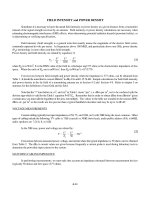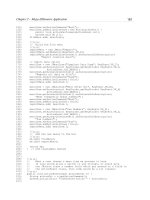Tài liệu Public-Key Cryptography and Key Management doc
Bạn đang xem bản rút gọn của tài liệu. Xem và tải ngay bản đầy đủ của tài liệu tại đây (768.69 KB, 39 trang )
J. Wang. Computer Network Security Theory and Practice. Springer 2009
Chapter 3
Public-Key Cryptography
and Key Management
J. Wang. Computer Network Security Theory and Practice. Springer 2009
Why Public-Key Cryptography?
To use data encryption algorithms in network communications,
all parities must first agree on using the same secret keys
Rely on couriers
Set up a meeting to determine a secret key
Use postal service, email service, phone service
…
However, these conventional methods are inflexible for network
communication applications
Public-key cryptography (PKC)
Invented in the 1970’s
Without the need of sharing prior secrets to distribute secret keys
securely
Can also be used for authentication
J. Wang. Computer Network Security Theory and Practice. Springer 2009
Chapter 3 Outline
3.1 Concepts of Public-Key Cryptography
3.2 Elementary Concepts and Theorems in Number
Theory
3.3 Diffie-Hellman Key Exchange
3.4 RSA Cryptosystem
3.5 Elliptic-Curve Cryptography
3.6 Key Distributions and Management
J. Wang. Computer Network Security Theory and Practice. Springer 2009
Basic Idea of PKC
Using conventional postal service, Bob can receive confidential
message from Alice without sharing prior secrets
The open padlock and the box: public key (open to public)
The key Bob keeps: private key (to be kept private)
Q: How to realize this idea in a mathematical form?
J. Wang. Computer Network Security Theory and Practice. Springer 2009
Another example
Suppose we have f
1
(f
0
(a, y), x) = f
1
(f
0
(a, x), y) and it is difficult to
derive x from f
0
(a, x) and a, which are publicly known
Alice does the following:
Randomly selects a positive number x
1
(private key) and sends
y
1
= f
0
(a, x
1
) to Bob
Bob does the same
Randomly generates x
2
and sends y
2
= f
0
(a, x
2
) to Alice
Alice calculates K
2
= f
1
(y
1
, x
2
) and Bob calculates K
1
= f
1
(y
2
, x
1
) as their
secret keys for a conventional encryption algorithm
Because f
1
(y
2
, x
1
) = f
1
(f
0
(a, x
2
), x
1
) = f
1
(f
0
(a, x
1
), x
2
) = f
1
(y
1
, x
2
),
they have K
1
= K
2
Malice may eavesdrop y
1
and y
2
, but still cannot find x
1
or x
2
Q: How to find such functions f
1
and f
2
?
J. Wang. Computer Network Security Theory and Practice. Springer 2009
Criteria for PKC
Forward efficiency
Computing encryption and decryption by legitimate parties must be easy
Generating a new key pair (K
u
, K
r
) must be easy, where K
u
is a public key
and K
r
the corresponding private key
Backward intractability
Computing M from ciphertext C and the public key K
u
must be
computationally intractable
In other words, K
u
must not leak out any useful information of K
r
Commutability (optional)
(K
u
, K
r
) must satisfy
May be needed for data authentications; not needed for key exchange
J. Wang. Computer Network Security Theory and Practice. Springer 2009
Chapter 3 Outline
3.1 Concepts of Public-Key Cryptography
3.2 Elementary Concepts and Theorems in Number
Theory
3.3 Diffie-Hellman Key Exchange
3.4 RSA Cryptosystem
3.5 Elliptic-Curve Cryptography
3.6 Key Distributions and Management
J. Wang. Computer Network Security Theory and Practice. Springer 2009
The Fundamental Theorem of Arithmetic
Any integer greater than 1 is a product of prime
numbers. Moreover, this product has a unique
representation if prime numbers are listed in non-
decreasing order.
Prime number theorem
Let n be an integer greater than 1 and π(n) be the
number of prime numbers that are less than n. Then
π(n) ~ n/ln n
J. Wang. Computer Network Security Theory and Practice. Springer 2009
Modular arithmetic
Let a and b be integers and m a positive integer
(a + b) mod m = (a mod m + b mod m) mod m
(a – b) mod m = (a mod m – b mod m) mod m
(a × b) mod m = (a mod m× b mod m) mod m
Congruence relations
a is congruent to b modulo m if a – b is divisible by m,
denoted by
J. Wang. Computer Network Security Theory and Practice. Springer 2009
Modular inverse:
Let a and n be positive integers with a < n. If there is a
positive integer b < n such that a•b ≡ 1 (mod n), then b
is a’s inverse modulo n
Finding modular inverse is a basic operation for the
RSA public-key cryptosystem
Note that modular inverse does not always exist
Euler’s totient function
The number of positive integers that are less than n
and relatively prime to n
J. Wang. Computer Network Security Theory and Practice. Springer 2009
Euler’s theorem:
Let a be a positive integer and n an integer greater
than 1 that is relatively prime to a, Then
Fermat’s little theorem:
Let p be a prime number and a be a positive integer
not divisible by p, then
J. Wang. Computer Network Security Theory and Practice. Springer 2009
Primitive roots:
If for any positive integer m < φ(n),
then a is called a primitive root modulo n
Not every integer n has a primitive root
Fast modular exponentiation:
a
x
mod n is a common operation in PKC
Naïve method to calculate a
x
mod n: First calculate
a
x
, then calculate modulo n. It incurs high time
complexity!!!
x is a positive integer. Let then
J. Wang. Computer Network Security Theory and Practice. Springer 2009
Thus,
An example in textbook on page 96
J. Wang. Computer Network Security Theory and Practice. Springer 2009
Finding Large Prime Numbers
How to efficiently determine whether a given odd number
n is prime
Check whether n has a factor x with
Time complexity:
J. Wang. Computer Network Security Theory and Practice. Springer 2009
Miller-Rabin’s primality test
A probabilistic algorithm; the probability of returning
false info is less than 2
-2m
, where m is the number of
iterations of the algorithm
Let n be an odd integer > 1 and k a positive integer
satisfying
n – 1 = 2kq, where q is an odd integer
J. Wang. Computer Network Security Theory and Practice. Springer 2009
The Chinese Remainder Theorem
A solution to a set of simultaneous congruence equations
Let i be a positive integer, Z
i
= {0, …, i-1}
Let n
1
, n
2
, …, n
k
be positive integers pairwise relatively prime
Let n = n
1
×n
2
×…×n
k
For any given set of simultaneous congruence equations
x ≡ a
i
(mod n
j
), where i = 1, …, k,
it has the following unique solution in Z
n
:
where b
i
= m
i
(m
i
-1
mod n
i
) and m
i
= n/n
i
J. Wang. Computer Network Security Theory and Practice. Springer 2009
Finite Continued Fractions
Finite continued fractions are fractional numbers of the form:
where a
0
is an integer, and a
1
…, a
k
are non-zero integers
J. Wang. Computer Network Security Theory and Practice. Springer 2009
Given a real number x, we can construct a continued
fraction to represent x as follows:
J. Wang. Computer Network Security Theory and Practice. Springer 2009
Chapter 3 Outline
3.1 Concepts of Public-Key Cryptography
3.2 Elementary Concepts and Theorems in Number
Theory
3.3 Diffie-Hellman Key Exchange
3.4 RSA Cryptosystems
3.5 Elliptic-Curve Cryptography
3.6 Key Distributions and Management
J. Wang. Computer Network Security Theory and Practice. Springer 2009
Diffie-Hellman Key Exchange
Diffie and Hellman provide a concrete
construction of functions f
0
and f
1
as follows:
f
0
(p, a; x) = a
x
mod p,
f
1
(x, b) = x
b
mod p
where p is a large prime and a is a primitive root
modulo p; public: (p, a); private: x
Thus, f
1
(f
0
(p, a; y), x) = f
1
(f
0
(p, a; x), y)
J. Wang. Computer Network Security Theory and Practice. Springer 2009
D-H Key Exchange Protocol
Alice:
Randomly selects a positive number X
A
< p (private)
Send Y
A
= f
0
(p, a; X
A
) = a
XA
mod p to Bob (public; a is also
public)
Compute K
A
= f
1
(Y
B
, X
A
) = Y
B
XA
mod p as Alice’s secret key
for a conventional encryption algorithm, where Y
B
is a
string sent from Bob
Bob:
X
B
Y
B
= f
0
(p, a; X
B
) = a
XB
mod p
K
B
= f
1
(Y
A
, X
B
) = Y
A
XB
mod p
J. Wang. Computer Network Security Theory and Practice. Springer 2009
Alice and Bob share the same secret key K = K
A
= K
B
Forward efficiency: fast modular exponentiation
Backward intractability: relying on the difficulty of solving
x from
y = a
x
mod p with x < p (this is called the discrete
logarithm problem)
Believed to be unsolvable in poly-time on conventional
computing devices
When p is sufficiently large, D-H Key Exchange is considered
secure
Malice can eavesdrop Y
A
or Y
B
, but has no ways to solve
X
A
or X
B
; but it’s vulnerable to the man-in-the-middle
attack
J. Wang. Computer Network Security Theory and Practice. Springer 2009
Man-in-the Middle Attacks
What Alice and Bob compute:
J. Wang. Computer Network Security Theory and Practice. Springer 2009
What Malice computes:
•
Alice and Malice have established a common secret key
•
Bob and Malice have established a common secret key
•
Alice and Bob have not established any common secret key
J. Wang. Computer Network Security Theory and Practice. Springer 2009
Elgamal PKC
Devised in 1985 and based on the D-H key
exchange protocol
Alice encrypts M as follows:
After receiving (C
1
, C
2
), Bob decrypts it by
calculating









